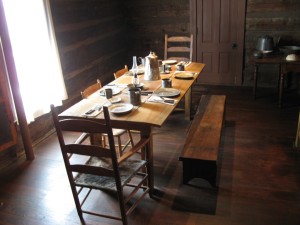The historic lands of the Apache spread from the Texas plains to the highland of central Arizona. In those cooler uplands, among juniper and ponderosa pine forests, bands of Western Apaches traded freely with neighboring Yavapai (Yah-vah-pie) groups. Then prospectors exploring along the Hassayampa River found gold.
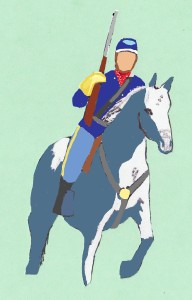 The time was 1863. The War between the States had been raging for two years back east. Both the North and South claimed the fledgling Arizona Territory, itself wrested from Mexico less than a decade previous. Confederate President Jefferson Davis ordered a troop of Texas cavalry to the old Spanish city of Tucson, in the Sonoran Desert to the south. After several skirmishes comprising the westernmost battles of the entire war, a force of California volunteers pushed the Texas men out, but Southern sentiment in Tucson remained strong.
The time was 1863. The War between the States had been raging for two years back east. Both the North and South claimed the fledgling Arizona Territory, itself wrested from Mexico less than a decade previous. Confederate President Jefferson Davis ordered a troop of Texas cavalry to the old Spanish city of Tucson, in the Sonoran Desert to the south. After several skirmishes comprising the westernmost battles of the entire war, a force of California volunteers pushed the Texas men out, but Southern sentiment in Tucson remained strong.

This article is a side trip from the regular “World of Apache Portal” Series. On the Edge of Apacheria, the area where the Apache once roamed, Northern and Southern interests collided during the Civil War to gain control of the Territory.
Attribution: Map details: Carl Grimsman; Underlying map including county lines: By NordNordWest [CC BY-SA 3.0 (http://creativecommons.org/licenses/by-sa/3.0)] via Wikimedia Commons
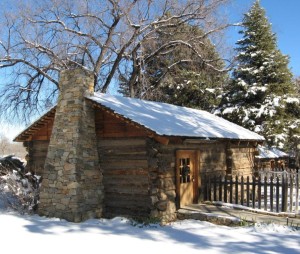
Built in 1864 this cabin was moved a half mile to its present location at Sharlot Hall Museum, Prescott, AZ
President Lincoln countered by sending a governor’s party to found a new territorial capital in the north. Their months-long journey with ox drawn wagons proceeded from Kansas with  difficulty.
difficulty.
Just ahead of them, a military contingent made camp and established Fort Whipple, at a spring near what is today the town of Chino Valley. A month later, in late January  1864, the new governor John Goodwin’s expedition reached them.
1864, the new governor John Goodwin’s expedition reached them.
The area chosen was rich in water and pasture, but lacked wood. And so, the next spring, after further exploration, both the fort and settlement were moved ten miles south to the banks of Granite Creek, at the edge of a vast pine forest.
This also put them nearer to the Pioneer 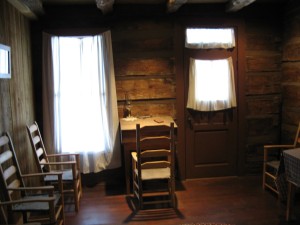 Mining District, pleasing the miners who had been petitioning the governor for a stouter military presence, providing protection not from Confederates but from Apaches and Yavapai raiders.
Mining District, pleasing the miners who had been petitioning the governor for a stouter military presence, providing protection not from Confederates but from Apaches and Yavapai raiders.
Life was harsh and simple, but the settlers and soldiers worked together to approximate the comforts of home.
The city was soon named Prescott (Press-kit as pronounced by locals) in honor of William Hickling Prescott (1796-1859), an admired historian who never travelled west of the Mississippi.
Prescott remained the territorial capital for three years, before the office moved to Tucson in 1867. Then in 1877 Prescott regained the honor only to have it pass permanently to the upstart city of Phoenix in 1889.
Although famous for its “Whiskey Row” downtown, frequented by the likes of Virgil Earp and Doc Holiday before their migration to Tombstone, Prescott is now called “Everybody’s hometown,” and has a downright friendly feel.
The city, thriving on ranching, tourism, retirement, and education, remains the capital and population center of Yavapai County.
Fort Whipple remained commissioned until 1913, serving as General Crook’s headquarters during several key years of the 1870s Apache Wars. During the Spanish-American War the fort was a mustering point for a volunteer regiment of Arizona Rough Riders. Today the historic grounds at Prescott include a museum, while many of the buildings continue life as the Northern Arizona VA Health Care Complex.
And the gold, well, that played out quick. Though many still pan for it in area streams such as Lynx Creek and Aqua Fria River.
The Yavapai Tribe continues to occupy a small reservation adjoining the fort, where in part, it manages a successful shopping center and hotel/casino.The Apache have three reservations in Arizona, including a one shared with their past allies. This is the Yavapai-Apache Reservation in the Verde Valley, near Camp Verde, another fort from the still recent days of the Arizona Territory.
Arizona officially entered statehood in 1912. It recently marked its sesquicentennial, in 2012, with an extensive exhibit and cultural fair that visited all three cities that have served as the capital.

Prescott Courthouse Square in the center of the city, hosts craft fairs, music events, a holiday lighting display, and 3 parades around its perimeter.
 Author Carl Grimsman has called the Prescott area home since 1996. His historical fantasy novel APACHE PORTAL is set in southern Arizona among the Chiricahua Apache and around the town of Tombstone, during these same early days on the Arizona frontier.
Author Carl Grimsman has called the Prescott area home since 1996. His historical fantasy novel APACHE PORTAL is set in southern Arizona among the Chiricahua Apache and around the town of Tombstone, during these same early days on the Arizona frontier.
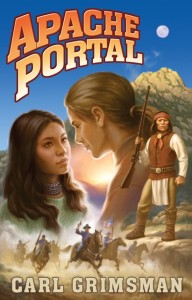 APACHE PORTAL is available from Amazon in ebook and paperback format
APACHE PORTAL is available from Amazon in ebook and paperback format
This is the fourth in a series of articles exploring The World of APACHE PORTAL.
This is also the first of a sub-series within it, taking side trips to The Edge of Apacheria. Apacheria is a name given to the area where the Apache roamed before Americans settled those parts of Arizona, New Mexico, Colorado, and Texas.
Photos, drawings, and text, unless otherwise noted, Copyright 2015 Carl Grimsman, All rights reserved.



